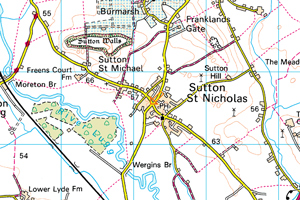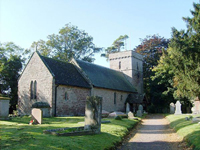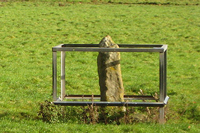BRIEF HISTORY OF SUTTON ST. NICHOLAS
 Sutton, or South Town so called because it lies south of Leominster, was formerly two parishes, Sutton St. Nicholas and Sutton St. Michael which were united in 1876. Sutton is situated on the left bank of the River Lugg 4 miles N.N.E. of Hereford. It is a small parish of 1612 acres approximately 2 miles across, north by south and east by west. It slopes on the one side towards the water-meadows on the banks of the River Lugg, and on the other side towards the marshy land through which runs the Little Lugg and its tributary brook the Rhea. The churches of St. Michael and St. Nicholas, Sutton Walls hill fort and the Wergin’s Stone are the principal historic monuments. Others include Ivy Cottage, Talbots Farm, The Creswells, and Pantalls Farm.
Sutton, or South Town so called because it lies south of Leominster, was formerly two parishes, Sutton St. Nicholas and Sutton St. Michael which were united in 1876. Sutton is situated on the left bank of the River Lugg 4 miles N.N.E. of Hereford. It is a small parish of 1612 acres approximately 2 miles across, north by south and east by west. It slopes on the one side towards the water-meadows on the banks of the River Lugg, and on the other side towards the marshy land through which runs the Little Lugg and its tributary brook the Rhea. The churches of St. Michael and St. Nicholas, Sutton Walls hill fort and the Wergin’s Stone are the principal historic monuments. Others include Ivy Cottage, Talbots Farm, The Creswells, and Pantalls Farm.
The Iron Age British tribes, who built the hill fort at Sutton Walls, lived in it continuously from about 350 BC to AD 200. Legend has it that Offa, King of Mercia built his palace there where Ethelbert, King of the East Saxons was murdered in AD 794. It is thought that the Anglo-Saxons inhabited Sutton from around AD 600. Sutton appears in the Domesday Book, Nigel Le Seculer the king’s physician, Hugh Lasne and Walter de Freine were the principal landowners each possessing ploughs, oxen and serfs. Village life was self-contained and justice was dispensed by the Lord of the Manor at Sutton Court or Freens Court.
Sutton was seriously affected by the Civil War. Being so close to Hereford, on the main road to Leominster, the Royalists and Puritan troops would frequently pass through and make requisitions. Sutton’s hero in the Civil War was Sir Harry Lingen who was High Sheriff of the county from 1638-43. He helped to defend Hereford against the Puritans on two occasions and was knighted for his efforts in 1645. He was imprisoned and fined by the Commonwealth, but was restored to Parliament after the Restoration in 1660.
 The church of St. Nicholas dates back to the 12th century and at that time the lordship of Sutton was held by the de Fresne or Freine family. Sutton St. Nicholas is to be identified as Sutton Freen. The church was enlarged in the 13th/14th centuries. The spire was removed in the mid-18th century as the cost of repairs could not be met. The majority of repairs and alterations were made in the 19th and 20th centuries.
The church of St. Nicholas dates back to the 12th century and at that time the lordship of Sutton was held by the de Fresne or Freine family. Sutton St. Nicholas is to be identified as Sutton Freen. The church was enlarged in the 13th/14th centuries. The spire was removed in the mid-18th century as the cost of repairs could not be met. The majority of repairs and alterations were made in the 19th and 20th centuries.
The church of Sutton St. Michael also dates back to the 12th century. The church, lands and tithes were paid to the priory of St. Guthlac (now the site of the bus station in Hereford). Towards the end of the 12th century, the Priory made over its rights in St. Michael to the Knights Hospitallers of St. John to form a large estate controlled from their headquarters at Dinmore. Their headquarters in Sutton were at Overcourt. In the 16th century the Sutton estate was acquired by the Lingen family from Freen’s Court. The church was restored in the mid-19th century, again in the early 20th century and most recently the bell tower was restored in the early 21st century.
 The Wergin Stone which stands on the left-hand side of the Sutton to Hereford road (near the 3rd mile stone) has been described as a “megalithic pre-historic structure of shaft and base” (Martin 1953). However its true date is unknown and it has been suggested it may have been a flood marker. The base is an irregular pentagon with a cavity on its top, the shaft is let into the base at its narrow end in a mortice hold. It was known as “Ye Divell’s Stone” after it mysteriously moved 240 paces in 1641/2 and had to be relocated to its original site. Photograph © Copyright Pauline Eccles and licensed for reuse under this Creative Commons Licence
The Wergin Stone which stands on the left-hand side of the Sutton to Hereford road (near the 3rd mile stone) has been described as a “megalithic pre-historic structure of shaft and base” (Martin 1953). However its true date is unknown and it has been suggested it may have been a flood marker. The base is an irregular pentagon with a cavity on its top, the shaft is let into the base at its narrow end in a mortice hold. It was known as “Ye Divell’s Stone” after it mysteriously moved 240 paces in 1641/2 and had to be relocated to its original site. Photograph © Copyright Pauline Eccles and licensed for reuse under this Creative Commons Licence
